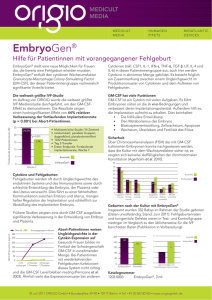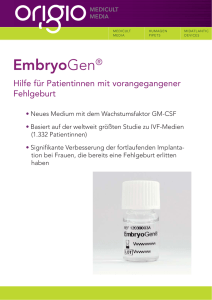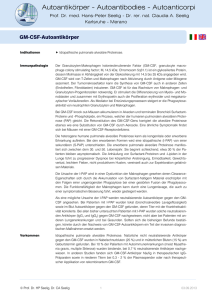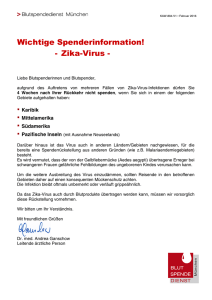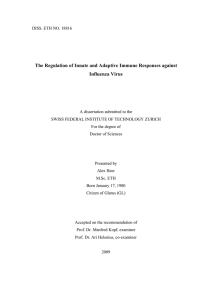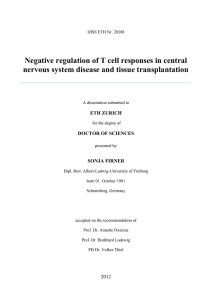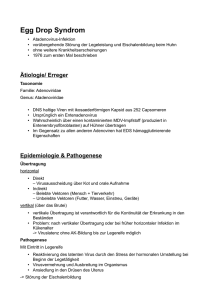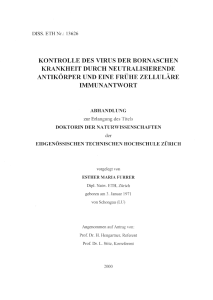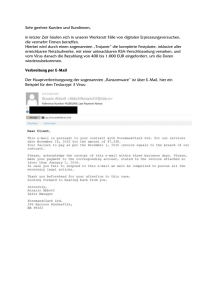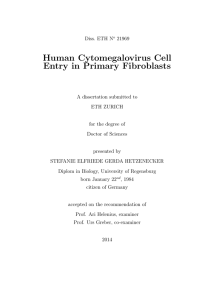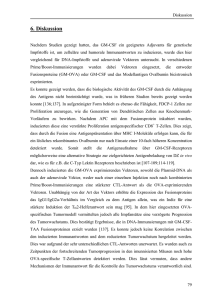Host genes influencing the susceptibility to viral - ETH E
Werbung
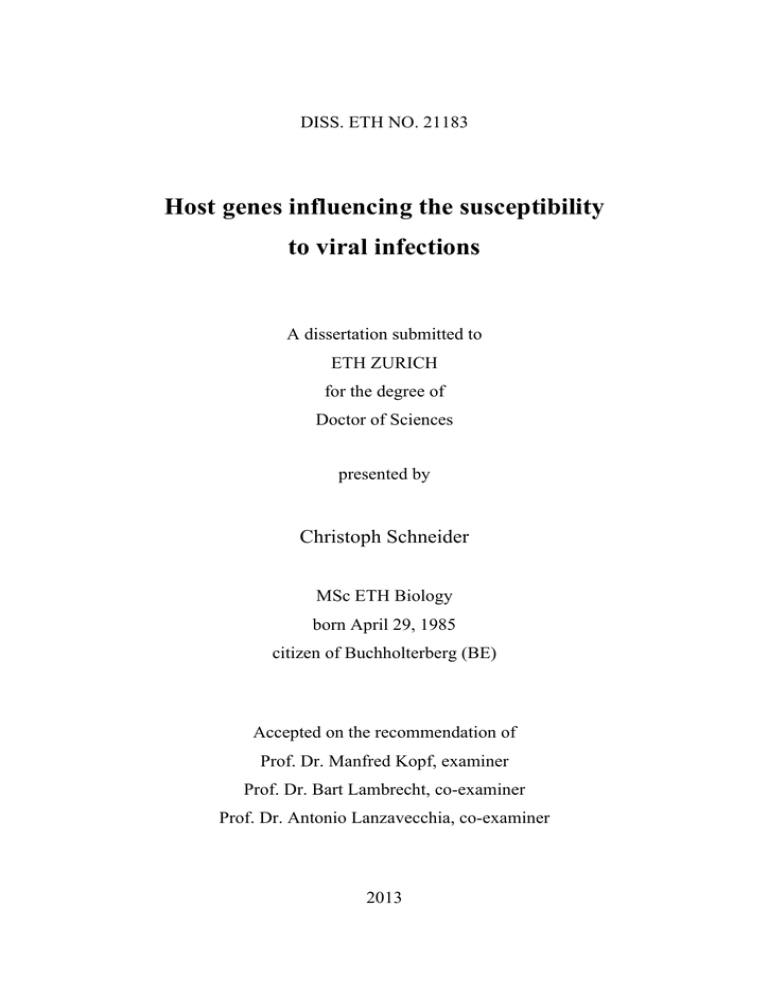
DISS. ETH NO. 21183 Host genes influencing the susceptibility to viral infections A dissertation submitted to ETH ZURICH for the degree of Doctor of Sciences presented by Christoph Schneider MSc ETH Biology born April 29, 1985 citizen of Buchholterberg (BE) Accepted on the recommendation of Prof. Dr. Manfred Kopf, examiner Prof. Dr. Bart Lambrecht, co-examiner Prof. Dr. Antonio Lanzavecchia, co-examiner 2013 1. Summary 5 1. Summary Viral infections represent a significant cause of death and economic burden to the human population. To combat viral and other infections, evolution created a defence system with potent effector cells and molecules capable of killing infected cells to limit viral spread and eventually clear infection. Importantly, the host response must be balanced between killing of infected cells and prevention of immune-mediated tissue damage to ensure functionality of vital organs. Organ-resident immune cells such as tissue macrophages have an important function under steady state and during inflammation. This thesis focused on 3 host factors that we initially identified to influence T cell effector function and susceptibility to influenza virus infection. Subsequent characterization revealed important functions in the modulation of antiviral T cell responses against high dose LCMV infection (i.e. IL-9R) or in the development of alveolar macrophages (i.e. GM-CSF and PPARγ). The lung is continuously exposed to environmental substances and microbes. For such a vital organ, it is essential to maintain function under homeostasis as well as upon infection. Here, we describe two host factors, PPARγ and GM-CSF, which are crucial for resistance to influenza infection. Interestingly, both factors are critical for the development of alveolar macrophages (AM) revealing the delicate function of this cell type especially during pulmonary infections. AM are tissue resident macrophages of the lung and contribute to surfactant homeostasis in the alveolar space. According to the current understanding, GMCSF is required for maturation and function of AM. However, we here provide evidence that GM-CSF signalling is intrinsically required for licensing development of an AM progenitor shortly after birth. Accordingly, GM-CSF-deficient mice were completely devoid of AM, resulting in a striking accumulation of surfactant material in the bronchoalveolar space similar to the rare human disorder “pulmonary alveolar proteinosis (PAP) ”. Moreover, we describe a novel function of the transcription factor PPARγ, which is known to play an important role in adipocyte differentiation, as a key transcription factor in the terminal differentiation of AM but not other tissue macrophages and DCs. Absence of PPARγ resulted in the arrest of AM development at the stage of an immature AM precursor that display intracellular lipid accumulation and foam cell formation due to incapacity to degrade surfactant and cellular debris. These functional deficiencies correlated with a strikingly altered transcriptome 6 1. Summary including a reduced expression of various genes involved in intracellular lipid handling and metabolism. Consequently, mice lacking PPARγ in myeloid cells developed PAP and accumulated dead cells in the BAL similar to GM-CSF-deficient animals, even though this phenotype was more severe in the latter due to complete absence of AM, while arrested PPARγ-deficient immature AM contributed partially to surfactant homeostasis. When infected with influenza virus, reduced function or absence of AM was associated with enhanced disease severity and increased mortality due to respiratory failure. In contrast to an acute infection with influenza virus, LCMV can induce acute or chronic infection similar to HIV or HCV dependent on the viral isolate and the dose of infection. Persistence of the virus is paralleled by reduced effector function and increased inhibitory receptor expression in CD8+ T cells resulting in a state of exhaustion. When studying mice deficient in IL-9R (Il9r-/-) in models of acute and chronic virus infection, we consistently observed more activated and effector cytokine-producing CD8+ T cells indicating a regulatory role of IL-9R. Consequently, when infected with a dose of LCMV that establishes a persistent virus infection in WT mice, Il9r-/- mice induced an enhanced antiviral CD8+ T cell response and were able to clear the virus. Furthermore, upon increased infectious doses, Il9r-/- mice displayed enhanced disease severity and mortality associated with highly elevated numbers of activated CD8+ T cells, which might promote immunopathology. Using BM chimeric mice and a newly generated mouse IL-9R-specific monoclonal antibody, we showed that IL-9R does not directly inhibit CD8+ T cell response but mediates its immunoregulatory role via radioresistant as well as radiosensitive cells. Preliminary results obtained in mast cell-deficient mice suggest an inhibitory function of mast cells during high dose LCMV infection, which could be linked to their expression of IL-9R. Overall, in this thesis we described three host genes whose functions are crucial during viral infections. While GM-CSF and PPARγ are critically involved in the development of AM that are vital for maintenance of lung function and resistance to pulmonary viral infections, IL-9R signalling plays an immunoregulatory role during high dose LCMV infection, which might be important to prevent immunopathology and could contribute to exhaustion of antiviral CD8+ T cells. 2. Zusammenfassung 7 2. Zusammenfassung Virusinfektionen gehören zu den verbreiteten Todesursachen in der menschlichen Population und verursachen enorme ökonomische Schäden. Für die Abwehr von Infektionen entwickelte sich im Laufe der Evolution das Immunsystem, welches ausgestattet ist mit Effektor Zellen und Molekülen um virusinfizierte Zellen abzutöten, die Virusverbreitung zu stoppen und schlussendlich den Organismus komplett vom Virus zu befreien. Eine wichtige Eigenschaft der Wirtsabwehr ist die Regulation der Immunantwort, sodass die Bekämpfung von infizierten Zellen und das Ausmass an Gewebeschaden aufgrund Immunpathologie im Ausgleich gehalten werden können und die Funktionalität von lebenswichtigen Organen erhalten bleibt. Neben Zellen des Stroma und Parenchyms enthalten die meisten Gewebe zusätzlich Organ-spezifische Immunzellen, wie bspw. Gewebe Makrophagen, welche wichtige Funktionen in der Homöostase und während Entzündungen wahrnehmen. Die 3 in dieser Arbeit beschriebenen Faktoren (GM-CSF, PPARγ und IL-9R) wurden anfangs entdeckt, da sie Einfluss auf die Anfälligkeit auf oder die Stärke der Immunantwort gegen das Influenza Virus hatten. Die darauffolgende Charakterisierung offenbarte wichtige Funktionen in der Entwicklung der lungenresidenten Makrophagen (GM-CSF und PPARγ) bzw. in der Regulation der antiviralen T Zellantwort (IL-9R). Die Lunge ist in stetigem Kontakt mit Mikroben und Substanzen aus der Umwelt. Für dieses lebenswichtige Organ ist es essentiell, dass die Funktionalität sowohl in der Homöostase als auch während Infektionen erhalten bleibt. In dieser Arbeit werden zwei Wirtsfaktoren – PPARγ und GM-CSF – beschrieben, die wichtig sind für das Überleben einer Influenza Infektion. Interessanterweise sind beide Faktoren an der Entwicklung von Alveolarmakrophagen (AM) beteiligt und offenbaren deren wichtige Funktion in pulmonalen Infektionen. AM sind die gewebsspezifischen Makrophagen in der Lunge, die dazu beitragen, dass Produktion und Abbau von Surfactant im bronchoalveolaren Raum im Gleichgewicht gehalten wird. Bis anhin dachte man, dass GM-CSF für die terminale Differenzierung und Funktion von AM wichtig ist. Wir zeigen in dieser Arbeit jedoch Resultate, welche für eine intrinsische Rolle des GM-CSF Signalweges in der frühen Entwicklung von AM sprechen. In Mäusen ohne GM-CSF gibt es keine AM, welche normalerweise ca. 3 Tage nach Geburt in der Lunge auftreten. Die Abwesenheit von AM führt zu einer Akkumulierung von 8 2. Zusammenfassung Surfactantmaterial im bronchoalveolaren Raum ähnlich derjenigen, welche man in der seltenen humanen Erkrankung „Alveolarproteinose“ vorfindet. Im Gegensatz zu GM-CSF ist PPARγ als wichtiger Transkriptionsfaktor für die Adipogenese bekannt. Wir beschreiben hier eine neue spezifische Funktion in der terminalen Entwicklung von AM. Abwesenheit von PPARγ führt zu einer Fehlentwicklung in den AM, welche als Konsequenz einen reduzierten Abbau von Surfactantmaterial zeigen, was in intrazellulärer Lipidanreicherung und Schaumzell-Charakter resultiert. Diese Fehlentwicklung wird begleitet von einem veränderten AM-spezifischen Genexpressionsmuster und der Expression von Genen, welche typischerweise in anderen Gewebemakrophagen aber nicht AM zu finden sind und auf einen partiellen Verlust der AM-Identität hindeuten. Konsequenterweise entwickeln Mäuse mit AM-Defekt bedingt durch fehlendes PPARγ eine Alveolarproteinose, ähnlich derjenigen, welche man in GM-CSF Knockout Mäusen findet, wenn auch nicht gleich stark ausgeprägt bedingt durch die blosse Fehlentwicklung im Gegensatz zur kompletten Absenz von AM in Abwesenheit von GM-CSF. In beiden Fällen korreliert der Defekt in den AM mit einer erhöhten Morbidität und Mortalität in einer Influenza Virus Infektion. Obwohl beide Mausstämme eine normale Immunantwort gegen pulmonale Virusinfektionen generieren, sterben sie aufgrund respiratorischer Insuffizienz. Im Gegensatz zu einer akuten Infektion mit Influenza kann LCMV abhängig von der Dosis zu einer chronischen Infektion führen ähnlich wie HIV oder HCV. Die Virus Persistenz korreliert mit einem Zustand der „Erschöpfung“ in CD8+ T Zellen, welcher charakterisiert ist durch den Verlust der Effektor Funktion und erhöhter Expression von inhibitorischen Rezeptoren. Verglichen mit Wildtyp Mäusen zeigten IL-9R Knockout (Il9r-/-) Mäuse tendenziell einen erhöhten Grad an T Zell Aktivierung und Effektor Funktion in akuten und chronischen Virusmodellen. An der Grenze zwischen akutem und chronischem Verlauf zeigten Il9r-/- Mäuse eine verstärkte antivirale CD8+ T Zell Antwort, waren schneller virusfrei und weniger anfällig für die Entwicklung einer persistierenden Infektion, was auf eine regulatorische Funktion von IL-9R hindeutet. Des Weiteren zeigte sich mit zunehmender Virusdosis ein schwererer Krankheitsverlauf und eine erhöhte Mortalität in Il9r-/- Mäusen möglicherweise aufgrund verstärkter Immunpathologie. Mittels Knochenmark-Chimären und einem neuen Antikörper spezifisch für Maus IL-9R konnten wir beweisen, dass IL-9R keinen direkten inhibitorischen Effekt auf die CD8+ T Zellanwort hat, sondern diese immunregulatorische Wirkung indirekt über nicht-hämatopoietische und hämatopoietische Zellen vermittelt. Weiter lassen unsere Resultate in Mastzell-defizienten Mäusen auf eine 2. Zusammenfassung 9 regulatorische Funktion von Mastzellen in hochdosierten LCMV Infektionen schliessen, welche möglicherweise über IL-9R vermittelt wird. Zusammenfassend beschreibt diese Arbeit drei Faktoren, welche wichtige Funktionen während Virusinfektionen wahrnehmen. GM-CSF und PPARγ sind essentiell für die Entwicklung von AM und somit für die Lungenfunktion und das Überleben während respiratorischen Virusinfektionen. IL-9R spielt dagegen v.a. in hochdosierten LCMV Infektionen eine immunregulatorische Rolle und trägt möglicherweise entscheidend bei zur Vermeidung von Immunpathologie ist und zur “Erschöpfung” der CD8+ T Zellen.
